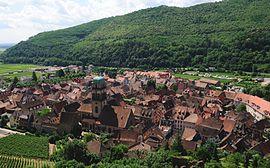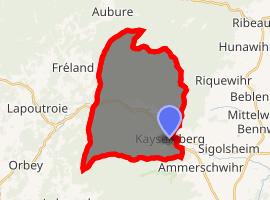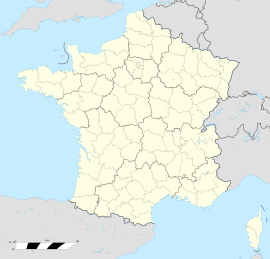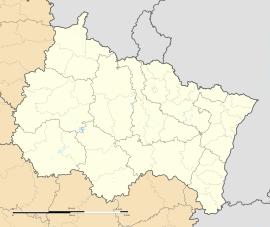Kaysersberg | |
|---|---|
Part of Kaysersberg Vignoble | |
 The town as seen from the castle | |
Location of Kaysersberg  | |
| Coordinates: 48°08′N 7°16′E / 48.14°N 7.26°E | |
| Country | France |
| Region | Grand Est |
| Department | Haut-Rhin |
| Arrondissement | Colmar-Ribeauvillé |
| Canton | Sainte-Marie-aux-Mines |
| Commune | Kaysersberg Vignoble |
| Area 1 | 24.82 km2 (9.58 sq mi) |
| Population (2017)[1] | 2,489 |
| • Density | 100/km2 (260/sq mi) |
| Time zone | UTC+01:00 (CET) |
| • Summer (DST) | UTC+02:00 (CEST) |
| Postal code | 68240 |
| Elevation | 236–924 m (774–3,031 ft) (avg. 240 m or 790 ft) |
| 1 French Land Register data, which excludes lakes, ponds, glaciers > 1 km2 (0.386 sq mi or 247 acres) and river estuaries. | |
Kaysersberg (German: ) is a historical town in Alsace in northeastern France. The name is German for Emperor's Mountain. The high fortress that dominates the town serves as a reminder of both its strategic importance and its warlike past.
Kaysersberg lies in the canton of Sainte-Marie-aux-Mines, which itself is a subdivision of the Colmar-Ribeauvillé arrondissement. It was a separate commune until 1 January 2016, when it was merged into the new commune of Kaysersberg Vignoble together with nearby Kientzheim and Sigolsheim, and remains its seat/[2]
In 2017 Kaysersberg was voted the Village préféré des Français (Village favoured by the French). The inhabitants are called Kaysersbergeois.
Geography
Kaysersberg lies about 12 kilometres (7 mi) northwest of Colmar, on the eastern slopes of the Vosges mountains.
Kaysersberg lies on the Route des Vins d'Alsace (Alsace "Wine Route"). Kaysersberg is near Ammerschwihr and Riquewihr.
Population
| Year | Pop. | ±% |
|---|---|---|
| 2006 | 2,715 | — |
| 2007 | 2,720 | +0.2% |
| 2008 | 2,726 | +0.2% |
| 2009 | 2,721 | −0.2% |
| 2010 | 2,713 | −0.3% |
| 2011 | 2,709 | −0.1% |
| 2012 | 2,705 | −0.1% |
| 2013 | 2,701 | −0.1% |
Economy
The area around Kaysersberg is one of the finest wine-growing areas in Alsace. The first vines were brought here in the 16th century from Hungary, and wine production is still an important aspect of the town's economy today. Wine produced from the pinot gris variety is a local specialty.
Tourism
Besides the fact that Alsace wine is produced locally, there is the ruin of Kaysersberg Castle. The ruins of Château de Wineck in Katzenthal, Château de Lupfen-Schwendi and Château de Reichenstein in Kientzheim are within walking distance.
Notable people
- Matthäus Zell (1477–1548), Protestant reformer
- Albert Schweitzer (1875–1965), theologian, musician, philosopher, and physician
Gallery
Albert Schweitzer museum
See also
- Communes of the Haut-Rhin département
References
- ^ Téléchargement du fichier d'ensemble des populations légales en 2017, INSEE
- ^ Arrêté 14 July 2015 (in French)
External links
.svg.gif)








